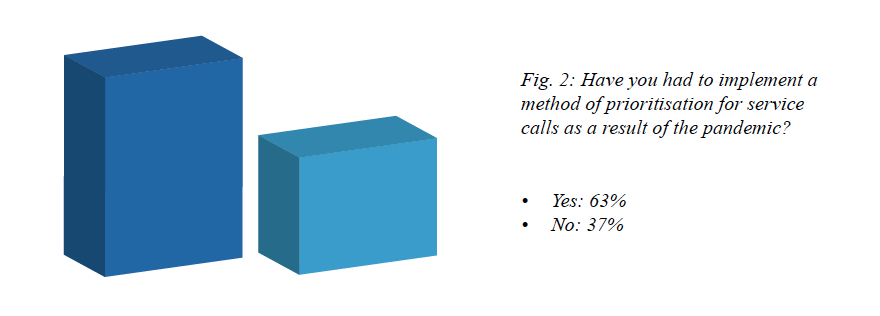As we continue our analysis of an exclusive Field Service News Research project run in partnership with FieldAware we explore how customer relationships have changed for field service organisations…
What is particularly interesting about the final comment above is that it shows an organisation directly responding to a very sudden shift in dynamic which has emerged amongst field service organisations.
One of the earliest changes that we saw arise amongst field service companies during the height of the lockdown was the need to prioritise service calls. This was of course, borne out of the necessity, in such chaotic times, we were all fighting fires – fortunately most of us in service management leadership, have honed that skill across the years.
What we found within the research study was that nearly two thirds of companies (63%) have had to implement a method of prioritisation for service calls during the pandemic. (Figure 2) However, what is perhaps more enlightening that almost half of the respondents (49%) believe that this will be an ongoing rather than temporary measure.
Could a company’s ability to opt for a lower level prioritisation within their service contract – as our respondent commented, be something that we begin to see become more prevalent as our customers look to find a balance between a necessity for service and a restriction of funds within the market.

Possibly, although it does appear that we are still in a state of flux and the hard lines of which direction we are going in as a sector are not fully formed. The study revealed that just under a quarter (24%) of companies state they are uncertain as to whether the measures they are taking now regarding customer prioritisation will be temporary or something they will continue to implement beyond the recovery.
What is clear though is that throughout the COVID-crisis, those companies that have been closest to their customers are the ones who have adapted and faced up to the challenges presented to us all the best. Over a third of the respondents (35%) stated that the amount of time they spend communicating with their customers has increased during the pandemic.
In fact, over two thirds (67%) of the respondents to the study stated that they speak to their customers on at least a weekly basis with more a third (33%) of the total respondents saying that they speak to their customers on a daily basis.
Furthermore, well over three quarters of the respondents anticipate that this level of communication will continue after the recovery. Indeed, as we begin to work our way through the findings of the survey, while the data reveals in one way the tale of hardship, challenge and struggle that we would certainly expect, there is also an undertone emerging across the trends of a refinement and general shift towards what has previously been outlined as the core habits of the best-in-class service providers. This focus on customer-centricity is just one such theme that fits within this category and to further highlight this 85% of customers outlined that they now have more than one touch point within their customer’s organisation that they regularly communicate with.

Want to know more?
FSN PRO and FSN PRO+ users can find the full paper this article is taken from in the premium resource library.















